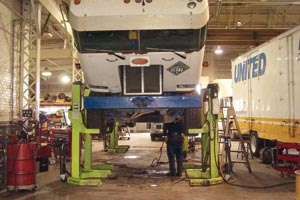Senior Reporter
Agreement Gives Repair Shops, Fleets Access to Greater Levels of OEM Data

Trade groups representing independent repair shops and parts distributors and one for truck and engine makers said they reached an agreement that will give fleets, truck owners and independent repair shops nearly complete access to the manufacturers’ information, tools and parts needed for proper repair of heavy-duty on-highway commercial vehicles.
The agreement puts the independents on a par with dealerships for the first time.
Playing key roles in crafting it were the Truck and Engine Manufacturers Association and the Commercial Vehicle Solutions Network, which represents independent aftermarket distributors.
The voluntary memorandum of understanding, which also includes provisions for licensing fees, takes effect Jan. 1.
“The [memorandum of understanding] was developed to address concerns expressed by independent service providers that they have better and more timely access to OEM-controlled information,” EMA President Jed Mandel said in a statement. “It addresses the unique characteristics of the heavy-duty vehicle manufacturing industry as well as the special needs of independent heavy-duty repair shops.”
Mandel added, “With that accomplished, we can avoid a patchwork and potentially disruptive effort to regulate service information through government action.”
EMA said the California Air Resources Board and U.S. Environmental Protection Agency regulations require all engine manufacturers to provide certain diagnostic and service information for engines and emissions systems used in heavy-duty trucks.
Massachusetts has a right-to-repair law, and other states have considered it, according to CVSN.
Also, all engine manufacturers have online systems to provide service information to owners and repair facilities, EMA said. However, at issue was the thoroughness of that information.
According to a summary of the Sept. 14 agreement and the process to reach it — provided by CVSN and confirmed by EMA — the vehicle manufacturers now will make available the same diagnostic information and repair code descriptions that are available to the dealers for model year 2010 and later trucks and buses exceeding 10,000 pounds sold in the United States and Canada. Exceptions include motor homes and vehicles with off-road engines.
This information now will include critical wiring diagrams and locations of sensors and controllers, and the ability to reflash the onboard computer modules after the repair, the document said.
Also involved in crafting the agreement were the Equipment and Tool Institute, the Auto Care Association and Heavy Duty Aftermarket Canada, according to EMA.
Marc Karon, chairman of the Commercial Right to Repair Coalition, called the memorandum a “significant accomplishment for all parties.”
Karon, also president of Total Truck Parts Inc., said that, given the computer-controlled nature of today’s complex heavy-duty vehicles, “having access to the correct information and latest diagnostic tools is essential to being able to complete repairs for our customers.”
Asked what is voluntary about the agreement, Karon told TT the agreement is not a legal requirement, and either party can terminate it with 30 days of notice.
“But it is unlikely that this will ever happen,” he added. “First, after we started to negotiate [with EMA and its members], we found that we both had common goals,” noting all parties wanted mutual customers to have correct repairs, done in an efficient manner, and guaranteeing safety.
“All parties agreed early on that this was best done with a fair approach to access to information and repair capability,” Karon said.
Also, the agreement stipulates that, beginning in 2018, each of the vehicle manufacturers will provide access to its onboard diagnostic and repair information system utilizing a nonproprietary vehicle interface and software that can run on an off-the-shelf personal computer utilizing an online connection, according to the repair groups’ summary.
It said this will enable independent repair shops and vehicle owners to use one tool to repair multiple nameplates.
All the industry associations said that, under the terms of the memorandum, they will work together to monitor the exchange of service information and address any information-access issues to ensure proper and safe maintenance.
Each side also agreed to forgo efforts to bring about additional legislation in this area.




